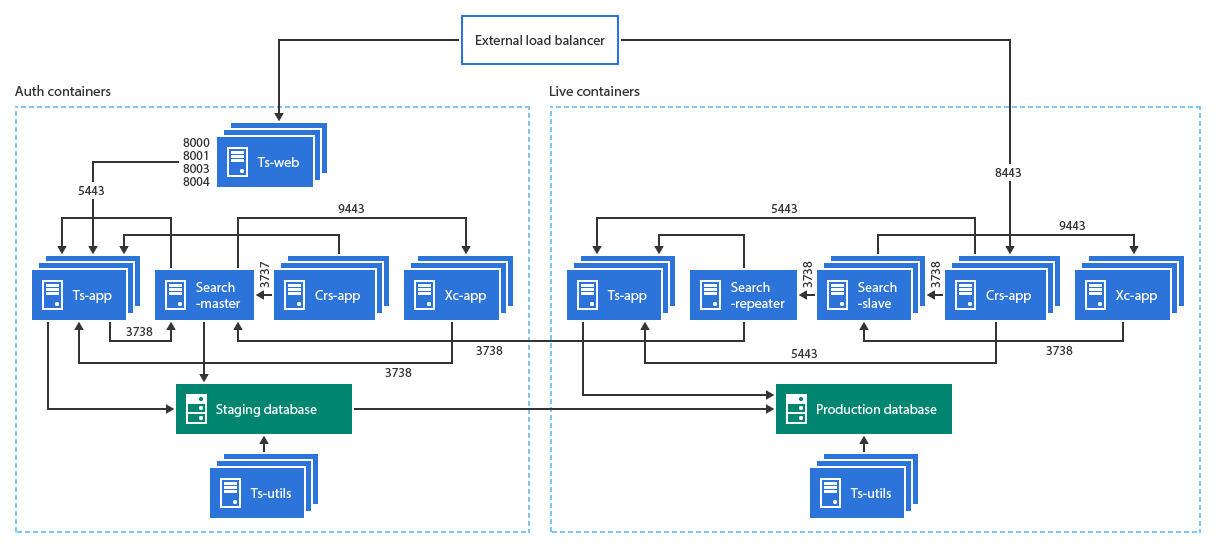HCL Commerce production environment overview
- Transaction server Docker image
- This image contains the Transaction server, running on the WebSphere Application Server. The Transaction server contains the transactional business logic and APIs that serve
the other servers of an HCL Commerce application. By default, when you
deploy the container, the container is called
ts-app.Note: If you migrate your store from IBM Websphere Commerce Version 7 or IBM Websphere Commerce Version 8, your store is running in the Transaction server Docker, not the Store server Docker. - IBM HTTP Server Docker image
- This image contains IBM HTTP Server, which is used as the
web server to access the HCL Commerce
tooling such as the Management Center and
the Administration Console. By default
when you deploy the container, the container is
called
ts-web. - Search server Docker image
- This image contains the Search server to run the Solr search index. This image utilizes
WebSphere Application Server V8.5.5 Liberty as its application server. By default when you
deploy the container, the container is called
search-app.The Search server Docker image can be set as different search node types:- search-master
- Handles indexing from the staging or authoring node, and provides read/write
capabilities. Multiple-node configurations are not supported for the
search-master; there can be only one. To set the Docker image as the
search-master, specify the following Docker
parameters:
SOLR_MASTER=true SOLR_SLAVE=false
- search-repeater
- Triggers by index replication and synchronizes the index from the
search-master. Search-repeater does not provide write capabilities. To set the
Docker image as a search-repeater, specify the following Docker
parameters:
SOLR_MASTER=true SOLR_SLAVE=true - search-subordinate
- Synchronizes index from the search-repeater. To set the Docker image as the
search-subordinate, specify the following Docker
parameters:
SOLR_MASTER=false SOLR_SLAVE=true
- Store server Docker image
- This image contains the Store server to serve store assets including JSP files, e-Marketing
Spots, and images. This image utilizes WebSphere Application Server V8.5.5 Liberty as its
application server. By default when you deploy the container, the container is called
crs-app.Note: If you migrate your store from IBM Websphere Commerce Version 7 or IBM Websphere Commerce Version 8, your store is running in the Transaction server Docker, not the Store server Docker. - Customization server Docker image
- This image contains the Customization server, which runs custom code that you can create to extend
HCL provided xC extension points. This image utilizes WebSphere Application Server V8.5.5 Liberty
as its application server. By default when you deploy the container, the container is
called
xc-app. - Utility server Docker image
- This image contains a utility project that holds
scripts to service HCL Commerce
operations such as loading access control
policies, loading store data, and cleaning
database of obsolete objects. By default when you
deploy the container, the container is called
ts-utils.
In addition to the Docker images, you will need to use an IBM Db2, or Oracle database. For development and test environments you can use the preconfigured Db2 Docker container.
You can build on top of the HCL provided Docker images to include custom code, custom configurations, and additional third party certificates. With the HCL Commerce application running on containers, you can deploy new containers separately as needed.
Sample HCL Commerce production system
crs-app):
ts-web) does not exist on the live instance. For a native remote HCL Commerce Version 9 store, the ts-web container is not required. Storefront requests
are handled directly by the Store server (crs-app). If you
need access to HCL Commerce tools directly on the live instance (for example, to make
emergency updates to your live store through the tools), then you can also deploy
ts-web to your live instance.If you migrated your store from WebSphere Commerce Version 7 or Version 8,
then your store resides on the Transaction server (ts-app) instead of the Store server (crs-app). In this instance, a Transaction server web server (ts-web) is required to serve static assets. For
more information, see Migrating a legacy WebSphere Commerce store.
HCL Commerce in production
Ensure that you have a strategy for managing and maintaining the container lifecycle of your production environment. For more information, see Planning your production environment infrastructure.